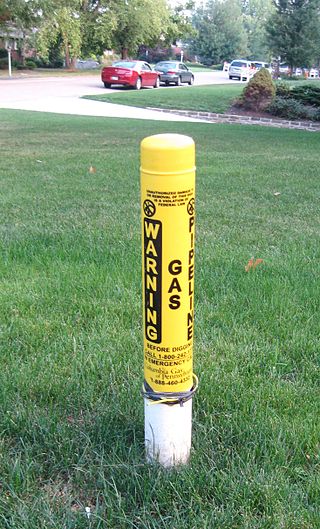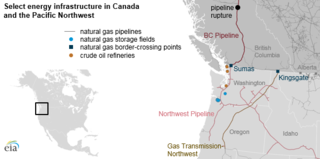Related Research Articles

The Federal Energy Regulatory Commission (FERC) is the independent agency of the United States government that regulates the transmission and wholesale sale of electricity and natural gas in interstate commerce and regulates the transportation of oil by pipeline in interstate commerce. FERC also reviews proposals to build interstate natural gas pipelines, natural gas storage projects, and liquefied natural gas (LNG) terminals, in addition to licensing non-federal hydropower projects.
Cheyenne Plains Gas Pipeline is a pipeline that brings gas from the Rocky Mountains to the Midwest. It is owned by El Paso Corporation. Its FERC code is 188.

Columbia Gas Transmission is a natural gas pipeline that gathers gas in the Gulf of Mexico and transports it to New York. Its pipelines are in Pennsylvania, New Jersey, Maryland, Ohio, Virginia and West Virginia. It is owned by TransCanada Corporation. Its FERC code is 21.
East Tennessee Natural Gas Pipeline is a natural gas pipeline that brings gas from eastern Tennessee to Virginia and North Carolina. It was formerly owned by Duke Energy but is now owned by Enbridge. Its FERC code is 2.
Enbridge Pipelines is a collection of four different systems of natural gas pipelines, all owned by Enbridge. They include the Enbridge Pipelines (AlaTenn) system, the Enbridge Pipelines (MidLa) system, the Enbridge Offshore Pipelines (UTOS) system, and the Enbridge Pipelines (KPC) system.
Florida Gas Transmission is a natural gas pipeline which brings gas from Texas, Louisiana, Mississippi, and Alabama into Florida. The pipeline is owned 50% by Energy Transfer Partners (Owner/Operator) and 50% by Kinder Morgan Partnership, each respectively representing units in Citrus Corporation (CitCor). Its FERC code is 34.

The Garden Banks Pipeline is a 30-inch diameter natural gas transmission pipeline which gathers gas from the offshore Gulf of Mexico and brings it into Enbridge Pipelines UTOS system, which leads into various locations in Louisiana and Texas. One end of the pipeline originates from Cameron, Louisiana, and it spans for 50 miles. Since 2005, the pipeline itself is 100% owned by Enbridge Offshore L.L.C., a subsidiary of the multinational pipeline company Enbridge, which has the longest pipeline system in North America. Its FERC code is 148. According to the FERC website, the company total cost for pipeline operations in the 2022 fiscal year was $60,318, 949.
Gas Transmission Northwest (GTN) is a 1,353 miles (2,177 km) long natural gas pipeline built in 1961 with a capacity of 2,900 million cubic feet per day. It brings gas from Alberta, Canada, beginning at Kingsgate, British Columbia and passing through Washington and terminates at Malin, Oregon then connecting to California, connecting to the Pacific Gas and Electric system. Prior to being purchased by TransCanada Corporation in 2004, it was named Pacific Gas Transmission. TransCanada subsequently sold 25 percent of its interest in GTN to TC PipeLines, LP, which connects via the Tuscarora Gas Pipeline. GTN's FERC code is 86.
Great Lakes Transmission is a natural gas pipeline that brings gas from western Canada through Minnesota, Wisconsin and Michigan before re-entering Canada. Along the way it provides gas to ANR Pipeline. Its FERC code is 51.
Gulfstream Natural Gas Pipeline is a natural gas pipeline that brings gas from Mississippi and Alabama, underwater across the Gulf of Mexico, to Florida. It was owned by Duke Energy, but is now owned by Enbridge. Its FERC code is 183.
Iroquois Gas Transmission System is a natural gas pipeline that brings gas from eastern Canada to the New York City area.

Kern River Pipeline is a 1,679-mile (2,702 km) long natural gas pipeline line extending from southwestern Wyoming to its terminus near Bakersfield, California. The pipeline supplies local gas distribution companies, power plants, and heavy industry in Utah, Nevada, and California. It is owned and operated by the Kern River Gas Transmission Company, a subsidiary of Berkshire Hathaway Energy. Its FERC code is 99.
The North Baja Pipeline is an overall 220-mile (350 km), bidirectional natural gas pipeline that can deliver gas from Arizona, through California, and into Mexico or from Mexico into the United States.
Northern Border Pipeline is a natural gas pipeline which brings gas from Canada through Montana, North Dakota, South Dakota, Minnesota, and Iowa into the Chicago area. It is owned by TC PipeLines, LP and ONEOK Partners and is operated by TC PipeLines, LP. Its FERC code is 89.

Northwest Pipeline is a natural gas pipeline network which takes gas from western Canada and the Rocky Mountains via the Westcoast Pipeline and brings it into California, either through Gas Transmission Northwest or Kern River. A small amount of gas goes through the San Juan Basin to El Paso Natural Gas. It is owned by the Williams Companies. Its FERC code is 37.
Stingray Pipeline is a natural gas pipeline which brings natural gas from the offshore Gulf of Mexico to Louisiana. It is owned by Energy Transfer. Its FERC code is 69.
Texas Gas Transmission is a natural gas pipeline which brings gas from the Louisiana Gulf coast up through Arkansas, Mississippi, Tennessee, and Kentucky, to supply gas to Illinois, Indiana, and Ohio. It is owned by Boardwalk Pipelines. Its FERC code is 18.
Vector Pipeline L.P. is a 348-mile-long natural gas pipeline which transports approximately 1 billion cubic feet (28,000,000 m3) per day of natural gas from Joliet, Illinois, in the Chicago area, to parts of Indiana and Michigan and into Ontario, Canada. The pipeline is important in the supply and transportation of natural gas from the United States and Western Canada to the Midwest, eastern Canada and the northeastern United States, supplying power generation plants, natural gas distribution companies, and natural gas storage facilities. The pipeline also has interconnections with several other natural gas pipelines along its route.
Williston Basin Pipeline is a natural gas pipeline system which moves gas between Wyoming, Montana, South Dakota, and North Dakota. It is owned by MDU Resources Group. Its FERC code is 49.

The Natural Gas Act of 1938 was the first occurrence of the United States federal government regulating the natural gas industry. It was focused on regulating the rates charged by interstate natural gas transmission companies. In the years prior to the passage of the Act, concern arose about the monopolistic tendencies of the transmission companies and the fact that they were charging higher than competitive prices. The passage of the Act gave the Federal Power Commission (FPC) control over the regulation of interstate natural gas sales. Later on, the FPC was dissolved and became the Federal Energy Regulatory Commission (FERC) pursuant to a different act. FERC continues to regulate the natural gas industry to this day.
References
- ↑ "FERC: Three Digit Pipeline Code List for Index of Customers (Form 549B)". Archived from the original on 2019-01-20. Retrieved 2017-11-28.